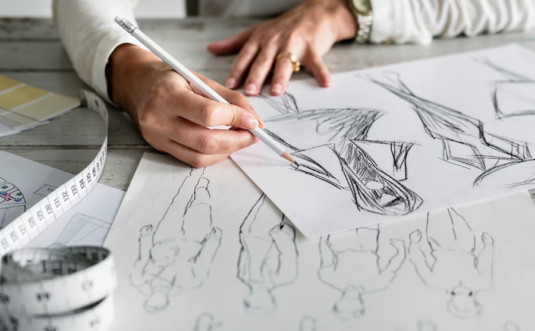In a world facing the challenges of climate change and environmental degradation, it has become increasingly important to support and protect the environment. One area where this support is crucial is the fashion industry. As fashion enthusiasts, designers, and consumers, we have the power to make a positive impact on the environment through our choices and actions. By embracing sustainable practices and promoting eco-friendly fashion, we can pave the way for a better future.
This article delves into the significance of supporting the environment and highlights the growing trend for recycling and eco-friendly flea markets. We will explore the innovative fashion design ideas that promote the second life of materials and reduce waste. Additionally, we will recognize the top five fashion designers who have released collections using recycled fabrics, showcasing their commitment to sustainability.
From reducing carbon emissions and conserving natural resources to minimizing waste and promoting ethical practices, supporting the environment through fashion design is a holistic approach that benefits both our planet and our well-being. So, let’s dive into the world of sustainable fashion and discover how we can make a positive change, one fashionable step at a time.
The Trend for Recycling and Eco-Friendly Flea Markets
The trend for recycling and eco-friendly flea markets has gained significant momentum in recent years. These markets provide a platform for individuals to sell or exchange pre-loved items, giving them a second life and diverting them from landfills. This movement not only promotes the concept of recycling but also encourages a shift towards a more sustainable and circular economy.
One of the primary reasons for the popularity of eco-friendly flea markets is the opportunity they provide to reduce textile waste. According to the Ellen MacArthur Foundation, the fashion industry produces a staggering 92 million tons of textile waste each year. By participating in these markets, individuals can contribute to reducing this waste by extending the life cycle of clothing and other fashion items.
Moreover, eco-friendly flea markets offer a unique shopping experience. They provide a treasure trove of vintage and one-of-a-kind items that cannot be found in conventional retail stores. By embracing second-hand fashion, consumers can express their individual style while reducing their environmental footprint.
These markets also promote a sense of community and connection. People from all walks of life come together to share their passion for sustainable fashion and engage in conversations about environmental responsibility. This creates a supportive and inspiring environment where like-minded individuals can exchange ideas and learn from one another.
The trend for recycling and eco-friendly flea markets is not limited to a specific region or demographic. It has gained popularity worldwide, with cities embracing the concept and organizing regular events. From small-scale pop-up markets to large-scale festivals, these events offer a diverse range of sustainable fashion options and attract fashion enthusiasts and eco-conscious individuals alike.
As the demand for sustainable fashion continues to grow, so does the need for innovative fashion design ideas that promote the second life of materials. Let’s explore some of the top ideas that are shaping the future of sustainable fashion.
Top Eco Ideas for the Second Life of Things
The second life of things refers to the concept of giving new purpose and value to materials that would otherwise be discarded. It involves transforming waste materials into new fashion pieces, accessories, or even home decor items.
Here are some of the top eco ideas that are gaining momentum in the world of sustainable fashion:
- Upcycling: Upcycling involves taking existing materials and transforming them into something of higher value or quality. Designers can repurpose old garments or textile scraps to create unique and fashionable pieces. For example, a worn-out denim jacket can be transformed into a stylish handbag, or a collection of fabric scraps can be sewn together to create a patchwork dress. Upcycling not only reduces waste but also adds a touch of individuality and creativity to fashion;
- Zero-waste design: Zero-waste design aims to eliminate textile waste at the production stage. Designers meticulously plan their patterns to ensure that every piece of fabric is utilized, leaving little to no scraps behind. This approach requires careful craftsmanship and innovative pattern-making techniques. By adopting zero-waste design principles, fashion designers can significantly reduce their environmental impact and create more sustainable collections;
- Clothing swaps: Clothing swaps are a fantastic way to give new life to garments that no longer serve their original owners. These events allow individuals to exchange their unwanted clothing items with others, providing an opportunity to refresh their wardrobe without contributing to textile waste. Clothing swaps encourage a sense of community, promote sustainable consumption, and offer a fun and affordable way to experiment with different styles;
- Textile recycling: Textile recycling involves transforming old garments or fabric scraps into new textile materials. Through mechanical or chemical processes, fibers are extracted from the old textiles and re-spun into new yarns or fabrics. This method helps reduce the demand for virgin resources and minimizes the environmental impact of textile production. Textile recycling is an innovative solution that allows fashion designers to create new collections while reducing their reliance on virgin materials;
- Collaborations with artisans: Collaborating with artisans and craftspeople who specialize in upcycling or repurposing materials can result in truly unique and sustainable fashion pieces. These collaborations not only support traditional craftsmanship but also foster a sense of cultural preservation. By combining modern design sensibilities with traditional techniques, fashion designers can create collections that celebrate heritage while promoting sustainability.
By embracing these eco ideas for the second life of things, fashion designers can play a significant role in supporting the environment. Through their creativity and innovation, they can reshape the industry and inspire others to follow suit. Now, let’s take a closer look at some of the world’s top fashion designers who are leading the way in sustainable fashion by releasing collections from recycled fabrics.
Fashion Designers Championing Sustainability
In recent years, an increasing number of fashion designers have recognized the importance of sustainability and have taken bold steps to incorporate recycled fabrics into their collections. These designers are trailblazers in the industry, demonstrating that eco-friendly fashion can be both chic and environmentally conscious.
Here are five notable fashion designers who have released collections from recycled fabrics:
1. Stella McCartney: Stella McCartney is a prominent advocate for sustainable fashion. Her brand is known for its commitment to using innovative and eco-friendly materials, including recycled polyester, regenerated cashmere, and sustainably sourced viscose. McCartney’s designs beautifully combine luxury and sustainability, proving that ethical fashion can be synonymous with style.
2. Eileen Fisher: Eileen Fisher is renowned for her timeless and minimalist designs, as well as her dedication to sustainable practices. Fisher uses a variety of recycled fabrics in her collections, such as recycled polyester, organic cotton, and reclaimed cashmere. By prioritizing materials that minimize environmental impact, she sets an example for the industry and inspires others to embrace sustainability.
3. Mara Hoffman: Mara Hoffman is a designer who infuses her collections with vibrant colors and bold prints. She is committed to using sustainable materials, including recycled polyester and Econyl®, a regenerated nylon made from discarded fishing nets and other nylon waste. Hoffman’s designs exemplify the fusion of sustainability and creativity, captivating fashion-conscious consumers who care about the environment.
4. Christopher Raeburn: Christopher Raeburn is renowned for his innovative approach to fashion design, which centers around the concepts of reusing and repurposing materials. Raeburn’s collections often feature recycled fabrics sourced from military surplus or other reclaimed materials. He embraces the challenge of transforming unconventional materials into high-quality fashion pieces, proving that sustainability and style can go hand in hand.
5. Maggie Marilyn: Maggie Marilyn is a New Zealand-based designer committed to creating ethically made and sustainable fashion. She incorporates recycled fabrics into her collections, using materials such as recycled polyester and Econyl®. Marilyn’s designs exude elegance and sophistication while reflecting her dedication to supporting the environment and promoting a circular fashion economy.
These fashion designers serve as role models for the industry, demonstrating that sustainable fashion is not just a trend but a necessity for a better future. Their use of recycled fabrics showcases the potential for creativity and innovation within sustainable fashion, inspiring others to follow suit.
Conclusion
In conclusion, supporting the environment through sustainable fashion is of paramount importance in our quest for a more eco-conscious future. The trend for recycling and eco-friendly flea markets offers an avenue to reduce waste and extend the life cycle of fashion items. Innovative fashion design ideas, such as upcycling and zero-waste design, provide opportunities for creative expression while minimizing environmental impact.
Fashion designers like Stella McCartney, Eileen Fisher, Mara Hoffman, Christopher Raeburn, and Maggie Marilyn are leading the charge in incorporating recycled fabrics into their collections, setting an example for the industry and inspiring others to embrace sustainability.
By supporting the environment through fashion, we can make a positive impact on the planet and create a more sustainable and ethical industry. So, let’s join forces and embrace fashion design ideas that prioritize the second life of things, shaping a future where style and sustainability go hand in hand.




